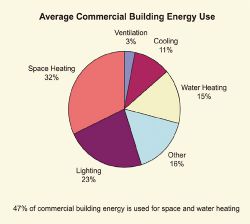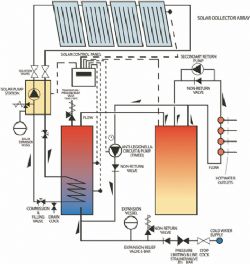There are advantages of separating the space heating and hot water functions in commercial applications and integrating renewable technologies, according to Jeff House
Improving the energy performance of commercial buildings is a significant part of EU and UK policies designed to reduce harmful emissions. The application of these evolving measures is set against an uneven background of compulsion, persuasion and inducement. As a result, energy users in commercial buildings may be excused for being uncertain of if, when and how these provisions apply. Consequently, the building services sector has a pivotal role in enabling well-informed decisions to be made.
The achievement of the UK commitment to an 80 per cent reduction in overall carbon emissions by 2050 will require a great deal of awareness and involvement on the part of energy consumers. Awareness is required, as nearly everything done in our technology- dependent world creates an energy demand of some sort, while involvement is essential, because there is an implicit requirement for every consumer to use energy more efficiently.
The timescale involved should not be seen as a reason for postponing carbon cutting action until a later time, nor should the role of individual consumers be seen as inconsequential within the grand picture.
As far as commercial buildings' energy performance is concerned, the immediacy in terms of response and specific actions is made clear by the Government's own findings and forecasts.
These show that around two million current commercial buildings are responsible for some 26 per cent of overall UK carbon emissions and that 75 per cent of today's building stock will still be in operation and consuming energy in 2050.

Clearly, new-build commercial projects, even though subject to stringent low carbon standards, will only provide a overall carbon reduction target. Energy performance of the existing commercial building stock is critical to achieving government aims and the steps necessary to achieve the required reduction in carbon emissions should have already begun at organisational level.
Particular attention should be paid to heating and hot water systems, which account for, on average, some 47 per cent of a commercial building's energy consumption. It has been recognised for many years that separation of the heating and hot water loads is the most energy efficient way of delivering these services in commercial, public and industrial buildings.
System separation
In simple terms, this means that boilers provide purely space heating, with the hot water demand being met by direct fired water heaters.
Whether or not the space heating and hot water components of the existing system have already been separated, building energy performance would benefit greatly from the retrofitting of a high efficiency direct-fired condensing water heater solution, from both energy and emission perspectives.
System separation reduces stored water volumes, requiring a smaller sized plant room, which is especially true if the hot water generation system is decentralised with units installed close to the point of use. Significantly, the reduced water storage requirement diminishes the risk of the legionella bacteria developing.

The installation of a direct-fired condensing storage water heater as part of a new system separation project, or its use to replace a standard efficiency direct-fired water heater in an existing separated system, offers greatly enhanced fuel efficiency. The level achieved is far greater than that delivered by a heating boiler and calorifier, or by a standard efficiency direct-fired water heater, which means that this technology can substantially reduce the building carbon footprint.
Separating the load can have further carbon saving benefits, as a separated system lends itself to the integration of renewable technologies. In principle, the selected renewable technology is used to pre-heat the cold water inlet to the direct-fired water heaters, which reduces the fossil fuel required to raise the stored water to the desired set-point temperature. Integrating renewable technologies such as solar thermal or heat pumps into a building heating and hot water system may enable an application to be made under the Renewable Heat Incentive (RHI) scheme.
In essence, tariff payments could apply in respect of measured heat generated by a building services system that uses an eligible technology.
Leading players in the heating industry, using a mixture of experience and innovation, are enabling commercial building energy users to make critical business decisions confident that full allowance has been made for energy policy goals. Well-established and proven system infrastructures, for example heating system separation solutions, together with adaptable and flexible system components enabling integration with developing renewable technologies, help deliver the required improvement in energy efficiency and reduction in environmental impact.
// The author is applications manager for Baxi Commercial Division //